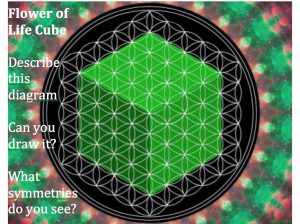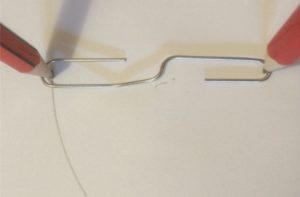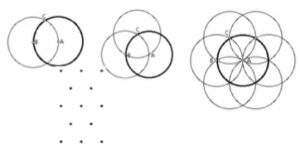Flower of Life
 Describe the picture? What do you notice? Talk with your friends about it. What shapes can you see in it?
Describe the picture? What do you notice? Talk with your friends about it. What shapes can you see in it?
Describe the different symmetries. Draw the picture yourself. Draw your own designs using this idea. Can you explain how this 2-dimensional picture appears to show a 3-dimensional object?
You could use paperclip compasses to draw the circles in this pattern.
 Click on the picture for a video showing how to draw circles with a paperclip.
Click on the picture for a video showing how to draw circles with a paperclip.
You will find it helpful to draw the circles with their centres on the lattice points of an isometric grid. Click here to download a dotty isometric grid. Start by first drawing 2 intersecting circles, then a third, then 4 more circles.
 From the centre there is first one circle. The next flower pattern has 7 circles altogether and the next pattern has 19 so the sequence for the number of circles starts 1, 7, 19, …
From the centre there is first one circle. The next flower pattern has 7 circles altogether and the next pattern has 19 so the sequence for the number of circles starts 1, 7, 19, …
Carry on this sequence of the number of circles as bands of circles are added around each pattern to make the next one in the sequence.
As an even more difficult challenge, could you describe this pattern to a friend over the phone who has not seen it, so well that she is able to draw it from your instructions, even though you have no way of showing her the picture?
 Ask more questions about the geometric properties of this picture and provide your own answers.
Ask more questions about the geometric properties of this picture and provide your own answers.
Make a display for your classroom wall and share photos of it with AIMSSEC.
Thank you Jain for giving AIMSSEC permission to use your images.
Why do you think Jain has called this the Flower of Life?
Please note the change from Grades to the more universal Years where Year 6 students are on average 11 years of age and Year 10 students are on average 15 years of age.
Click to download the Notes for Teachers.
South Africa COVID-19 News
Here is the official website for COVID-19 updates.
Login
SUPPORT AIMSSEC





